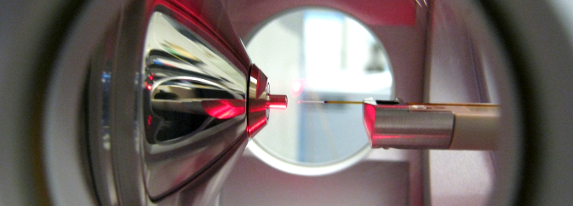Search for life in space descends to smaller scale
 A new technique could help scientists sift through space dust for the ingredients to make life.
A new technique could help scientists sift through space dust for the ingredients to make life.
The origin of the very basic building blocks that became life on Earth are still shrouded in mystery, but there is increasing evidence that material from space crashed down in comet and meteor impacts to boost the start of life.
Now, a team of NASA researchers are developing a better scan to sort through the molecules of a meteorite sample, looking for organic structures.
The NASA team is using a ‘nanoflow liquid chromatography’ instrument to sift through the molecules in a sample, then applying ‘nanoelectrospray ionization’ to give the molecules an electric charge. From here they are delivered to a high-resolution mass spectrometer instrument, which can identify individual molecules based on their mass.
Researchers have previously analysed carbon-rich meteorites (carbonaceous chondrites) to find amino acids, which are used to make proteins, which in turn form structures like hair, skin and even DNA.
However, these carbon-rich meteorites are rare, comprising less than five percent of recovered meteorites, and meteorites make up just a portion of the extraterrestrial material that comes to Earth. Also, the building-block molecules found in them usually have been at low concentrations, typically parts-per-million or parts-per-billion. This is why the scan has been developed to look for the absolutely miniscule traces in the samples so far.
The technique can also help search for the building blocks of life in smaller-scale extraterrestrial materials such as micrometeorites, interplanetary dust particles, and cometary particles, for future studies.
"Despite their small size, these interplanetary dust particles may have provided higher quantities and a steadier supply of extraterrestrial organic material to early Earth," said Michael Callahan, from NASA's Goddard Space Flight Center in Maryland.
“We found amino acids in a 360 microgram sample of the Murchison meteorite,” said Callahan.
“This sample size is 1,000 times smaller than the typical sample size used.”
“Murchison is a well-studied meteorite. We got the same results looking at a very small fragment as we did a much larger fragment from the same meteorite,” Callahan said.
“This technology will also be extremely useful to search for amino acids and other potential chemical biosignatures in samples returned from Mars and eventually plume materials from the outer planet icy moons Enceladus and Europa,” said Daniel Glavin, from the Astrobiology lab at Goddard.








 Print
Print